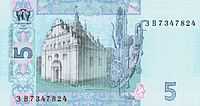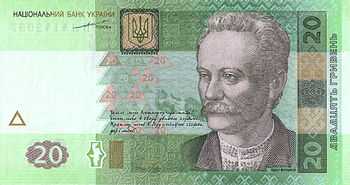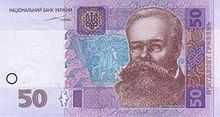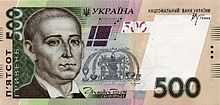Ukrainian hryvnia
| Ukrainian hryvnia | |||||
|---|---|---|---|---|---|
| українська гривня (Ukrainian) | |||||
| |||||
| Central bank | National Bank of Ukraine | ||||
| Website | www.bank.gov.ua | ||||
| User(s) |
| ||||
| Inflation | 24,9% (2014)[1] | ||||
| Source | Ukrstat | ||||
| Method | CPI | ||||
| Subunit | |||||
| 1/100 | kopiyka (копійка) | ||||
| Symbol | ₴ | ||||
| Plural | hryvni (гривні, nom. pl., after numbers ending with 2,3,4, but not with 12,13,14), and hryven’ (гривень, gen. pl., after other numbers) | ||||
| kopiyka (копійка) | kopiyky (копійки, nom. pl., after numbers ending with 2,3,4, but not with 12,13,14), kopiyok (копійок, gen. pl. after other numbers) | ||||
| Coins | 1, 2, 5, 10, 25, 50 kopiyok, ₴1 | ||||
| Banknotes | ₴1, ₴2, ₴5, ₴10, ₴20, ₴50, ₴100, ₴200, ₴500 | ||||
| Printer | National Bank of Ukraine | ||||
| Mint | National Bank of Ukraine | ||||
The hryvnia, sometimes hryvnya (Ukrainian: гривня, pronounced [ˈɦrɪu̯ɲɑ], abbr.: грн (hrn in Latin alphabet)); sign: ₴, code: UAH), has been the national currency of Ukraine since 2 September 1996. In Crimea, Donetsk, Luhansk and areas of Ukraine held by pro-Russian forces, the Russian ruble is used instead. The hryvnia is subdivided into 100 kopiyok. It is named after a measure of weight used in medieval Kievan Rus'.
Name
Etymology
The currency of Kievan Rus' in the eleventh century was called grivna. The word is thought to derive from the Slavic griva; c.f. Ukrainian, Russian, Bulgarian, and Serbo-Croatian грива / griva, meaning "mane". It may have indicated something valuable worn around the neck, usually made of silver or gold; c.f. Bulgarian and Serbian grivna (гривна, "bracelet"). Later, the word was used to describe silver or gold ingots of a certain weight; c.f. Ukrainian hryvenyk (гривеник), Russian grivennik (гривенник, "10-kopek piece").
The modern Ukrainian hryvnia is sometimes transliterated as hryvna, hrivna, gryvna or grivna, due to its Russian language counterpart, гри́вна, pronounced grívna. However, the standard English name for the currency is hryvnia.[2]
The National Bank of Ukraine has recommended that a distinction be made between hryvnia and grívna in both historical and practical means.
Plural
The nominative plural of hryvnia is hryvni (Ukrainian: гривні). This is also the genitive singular of hryvnia, while the genitive plural is hryven′ (Ukrainian: гривень). In Ukrainian, the genitive singular form is used for numbers ending with 2, 3, or 4, as in dvi hryvni (дві гривні, "2 hryvni"), and the genitive plural is used for numbers ending with 5 to 9 and 0, for example sto hryven’ (сто гривень, "100 hryven’"); for numbers ending with 1 the nominative singular form is used, for example dvadtsiat’ odna hryvnia (двадцять одна гривня, "21 hryvnia"). An exception for this rule is numbers ending in 11, 12, 13 and 14 for which the genitive plural is also used, for example, dvanadtsiat’ hryven’ (дванадцять гривень, "12 hryvnia"). The singular for the subdivision is копійка (kopiyka), the nominative plural is копійки (kopiyky) and the genitive is копійок (kopiyok). All these rules also apply in Polish, Russian and the most of other Slavic languages.
Currency sign

The hryvnia sign is a cursive Ukrainian letter He (г), with a double horizontal stroke, symbolizing stability, similar to that used in other currency symbols such as ¥ or €. The sign was encoded as U+20B4 in Unicode 4.1 and released in 2005.[3] It is now supported by the latest computer systems.
History

A currency called hryvna was used in Kievan Rus'. In 1917, after the Ukrainian National Republic declared independence from the Russian Empire, the name of the new Ukrainian currency became hryvnia, a revised version of the Kievan Rus' hryvna. The designer was Heorhiy Narbut.
The hryvnia replaced the karbovanets during the period 2–16 September 1996, at a rate of 1 hryvnia = 100,000 karbovantsiv. The karbovanets was subject to hyperinflation in the early 1990s following the collapse of the USSR.
To a large extent, the introduction of hryvnia was secretive.[4] Hryvnia was introduced according to President's Decree dated 26 August 1996, published on August 29. During the transition period, September 2–16, both hryvnia and karbovanets were used in circulation, but merchants were required to give change only in hryvnias. All bank accounts were converted to hryvnia automatically. During the transition period, 97% of karbovanets were taken out of circulation, including 56% in the first 5 days of the currency reform.[4] After 16 September 1996, the remaining karbovanets were allowed to be exchanged to hryvnias in banks.
The hryvnia was introduced during the period when Victor Yushchenko was the Chairman of National Bank of Ukraine. However, the first banknotes issued bore the signature of the previous National Bank Chairman, Vadym Hetman, who resigned back in 1993, because the first notes had been printed as early as 1992 by the Canadian Bank Note Company, but it was decided to delay their circulation until the hyperinflation in Ukraine was brought under control.
Initially, the foreign exchange rate was UAH 1.76 = USD 1.00. Following the Asian financial crisis in 1998 the currency devaluated to UAH 5.6 = USD 1.00 in February 2000. Later, the exchange rate remained relatively stable at around 5.4 hryvnias for 1 US dollar and was fixed to 5.05 hryvnias for 1 US dollar from 21 April 2005 until 21 May 2008. In mid-October 2008 rapid devaluation began with the hryvnia dropping 38.4% from UAH 4.85 for USD 1 on 23 September 2008 to UAH 7.88 for USD 1 on 19 December 2008.[5] After a period of instability, a new peg of 8 hryvnias per US dollar was established, and remained for several years. In 2012, the peg was changed to a managed float (much like that of the Chinese yuan) as the euro and other European countries' currencies weakened against the dollar due to the problems in Greece, and the value in mid-2012 was about 8.14 UAH per dollar.
On 18 March 2014, the government of Crimea announced that the Ukrainian hryvina was to be dropped as the region's currency in April 2014.[6]
Coins
No coins were issued for the first Hryvnia.
Coins were first struck in 1992 for the new currency but were not introduced until September 1996. Initially coins valued between 1 and 50 kopecks were issued.
In March 1997, 1 hryvnia coins were added; they are however rarely seen in circulation. The note of the same value is far more commonly used. Since 2004 several commemorative 1 hryvnia coins have been struck.
In October 2012 the National Bank of Ukraine announced that it is examining the possibility of withdrawing the 1 and 2 kopeck-coins from circulation.[7] The coins had become too expensive to produce compared to their nominal value.
Also, on 26 October 2012, the National Bank of Ukraine announced it is considering the introduction of a 2 Hryvnia coin.[8]
Banknotes
In 1996, the first series of hryvnia banknotes was introduced into circulation by the National Bank of Ukraine. They were dated 1992 and were in denominations of 1, 2, 5, 10 and 20 hryven’. The design of the banknotes was developed by Ukrainian artists Vasyl Lopata and Borys Maksymov.[9][10] One hryvnya banknotes were printed by the Canadian Bank Note Company in 1992. Two, five and ten hryvnya banknotes were printed two years later. Until introduction into circulation the banknotes were kept in Canada.[9]
Banknotes of the first series in denominations of 50 and 100 hryven' also existed but due to some reasons they were never introduced.
Also in 1996, the 1, 50, and 100 hryvnia notes of the second series were introduced, with 1 hryvnia dated 1994. The banknotes were designed and printed by British De La Rue.[11] Since the opening of the Mint of the National Bank of Ukraine in cooperation with De La Rue in March 1994 all banknotes have been printed in Ukraine.[11]
Later, highest denominations were added. The 200 hryvnia notes of the second series were introduced in 2001, followed by the 500 hryvnia notes of the third series in 2006.
All hryvnia banknotes issued by the National Bank continue to be a legal tender. As of 2008, the banknotes of early series can rarely be found in circulation. Also, despite the devaluing of the currency since its introduction, all kopeck coins remain in circulation, as well as all low-value hryvnia bills, including 1 hryvnia.
As with the U.S. dollar, the 1 hryvnia bill is commonly used, and the 1 hryvnia coin is rarely seen. The 100 hryvnia denomination is quite common due to its moderately high value. Also common is the 200 hryvnia, as most Ukrainian ATMs dispense currency in this denomination, much as with the US$20 bill.
Current series
| Denomination and dimensions | Image | Main colour | Obverse | Reverse | Date of issue | |
|---|---|---|---|---|---|---|
| ₴1 118 x 63 mm |
 |
 |
Yellow-blue | Volodymyr the Great (c. 958 – 1015), Prince of Novgorod and Grand Prince of Kyiv Ruler of Kyivan Rus in (980–1015) |
The Volodymyr I's Fortress Wall in Kyiv | 22 May 2006 |
| ₴2 118 x 63 mm |
 |
 |
Orange | Yaroslav the Wise (c. 978 – 1054), Prince of Novgorod and Grand Prince of Kyiv Ruler of Kyivan Rus in (1019–1054) |
The Saint Sophia's Cathedral in Kyiv | 24 September 2004 |
| ₴5 118 x 63 mm |
 |
 |
Blue | Bohdan Khmelnytsky (c. 1595 – 1657), Hetman of Ukraine | A church in the village of Subotiv | 14 June 2004 |
| ₴10 124 x 66 mm |
 |
.jpg) |
Crimson | Ivan Mazepa (1639 – 1709), Hetman of Ukraine | The Holy Dormition Cathedral of the Kyiv Pechersk Lavra | 1 November 2004 |
| ₴20 130 x 69 mm |
 |
 |
Green | Ivan Franko (1856 – 1916), poet and writer | The Lviv Theatre of Opera and Ballet | 1 December 2003 |
| ₴50 136 x 72 mm |
 |
 |
Violet | Mykhailo Hrushevskyi (1866 – 1934), historian and politician. | The Tsentralna Rada building ("Teachers' House" in Kyiv). | 29 March 2004 |
| ₴100 142 x 75 mm |
 |
 |
Olive | Taras Shevchenko (1814 – 1861), poet and artist | The Chernecha Hill near Cherkasy and the figures of a kobzar with his guide boy. | 20 February 2006 |
| ₴200 148 x 75 mm |
 |
 |
Pink | Lesia Ukrainka (1871 – 1913), poet and writer | The Entrance Tower of Lutsk Castle. | 28 May 2007 |
| ₴500 154 x 75 mm |
 |
 |
Brown | Gregory Skovoroda (1722 – 1794), writer and composer | One of the Kyiv Mohyla Academy buildings. | 15 September 2006 |

Exchange rates
Official NBU exchange rate at moment of introduction: UAH 1.76/USD 1.[12]
In the period from 21 April 2005 through 21 October 2008 the exchange rate was pegged at around UAH 5/USD 1. In 2008 in the course of a global financial crisis, the hryvnia was devalued to about 8/USD 1.[13] In accordance with the impossible trinity economic problem, having a fixed exchange-rate and free movements of capital (i.e. cross-border lending) have undermined the National Bank of Ukraine's ability to conduct an independent monetary policy.
As from 7 February 2014, following political instability in Ukraine, the National Bank of Ukraine changed the hryvnia into a fluctuating/floating currency in an attempt to meet IMF requirements and to try to enforce a stable price for the currency in the Forex market.[14]
| Current UAH exchange rates | |
|---|---|
| From Google Finance: | AUD CAD CHF EUR GBP HKD JPY USD RUB |
| From Yahoo! Finance: | AUD CAD CHF EUR GBP HKD JPY USD RUB |
| From XE: | AUD CAD CHF EUR GBP HKD JPY USD RUB |
| From OANDA: | AUD CAD CHF EUR GBP HKD JPY USD RUB |
| From fxtop.com: | AUD CAD CHF EUR GBP HKD JPY USD RUB |
| From Currency.Wiki: | AUD CAD CHF EUR GBP HKD JPY USD RUB |
See also
Notes
References
- ↑ http://www.ukrstat.gov.ua/operativ/operativ2006/ct/cn_rik/isc/isc_u/isc_gr_u.htm
- ↑ ISO 4217 currency names and code elements
- ↑
- Michael Everson's "Proposal to encode the HYRVNIA SIGN and CEDI SIGN in the UCS" (PDF). 23 April 2004. Retrieved 23 April 2004.
- ↑ 4.0 4.1 "Volodymyr Matvienko. Autograph on Hryvnia" (in Ukrainian).
- ↑ National Bank of Ukraine, historical exchange rates
- ↑ "Ukrainian hryvnia to be dropped in April: Crimean gov't official". CCTV News America. 18 March 2014. Archived from the original on 23 April 2014. Retrieved 18 March 2014.
- ↑ RBK Ukraina (4 October 2012). Available at:http://www.rbc.ua/rus/news/rubric/nbu-v-blizhayshie-mesyatsy-rassmotrit-vopros-o-tselesoobraznosti-04102012121300
- ↑ НБУ рассмотрит вопрос введения в обращение 2-гривневой монеты [RBK will consider the issuance of 2-hryvnia coin] (in Russian). RBK Ukraina. 26 October 2012. Archived from the original on 23 April 2014.
- ↑ 9.0 9.1 Как появилась гривна [How hryvnia was born] (in Russian). Podrobnosti. 4 September 2006. Archived from the original on 13 March 2014.
- ↑ "The man who designed Hryvnia". Zerkalo Nedeli (in Russian).
- ↑ 11.0 11.1 "Hryvnia-Immigrant". Zerkalo Nedeli (in Ukrainian).
- ↑ http://bank.gov.ua/control/uk/curmetal/currency/search?formType=searchFormDate&time_step=daily&date=17.09.1996&execute=%D0%92%D0%B8%D0%BA%D0%BE%D0%BD%D0%B0%D1%82%D0%B8
- ↑ http://www.google.com/finance?q=USDUAH
- ↑ "7 лютого 2014 року Національний банк України вводить в обіг пам’ятну монету “Визволення Нікополя від фашистських загарбників”" [7 February 2014 the National Bank of Ukraine will issue commemorative coins "Nikopol Liberation from the Nazis"]. 7 February 2014. Archived from the original on 8 February 2014.
Bibliography
- Krause, Chester L., and Clifford Mishler (1991). Standard Catalog of World Coins: 1801–1991 (18th ed.). Krause Publications. ISBN 0873411501.
- Cuhaj, George S. (editor) (2006). Standard Catalog of World Paper Money: Modern Issues 1961-Present (12th ed.). Krause Publications. ISBN 0-89689-356-1.
External links
| Wikimedia Commons has media related to Money of Ukraine. |
- History of Hryvnia
- National Bank of Ukraine announcement of Hryvnia Sign (Ukrainian)
- Proposed symbols for hryvnia during design competition (Ukrainian)
- Pictures of hryvnia bills introduced in 1997
- The first Ukrainian Money (1917-1922) Odessa Numismatics Museum
- Ukraine monetary reform. Numismatics (Russian)
- Ukrainian hryvnia coins catalog information
- Actual Ukrainian hryvnia exchange rates
| Preceded by: Various |
Currency of Kyivan Rus' 11th century – 15th century |
Succeeded by: Various |
| Preceded by: Ukrainian karbovanets |
Currency of Ukrainian People's Republic 1 March 1918 – April 1918 |
Succeeded by: Ukrainian karbovanets Reason: coup d'état (on 29 April 1918) |
| Preceded by: Ukrainian karbovanets Reason: coup d'état (on 14 December 1918) |
Currency of Ukrainian People's Republic December 1918 – November 1920 |
Succeeded by: Soviet karbovanets Reason: Soviet occupation |
| Preceded by: Ukrainian hryvnia |
Currency of Republic of Crimea 17 March 2014 – 1 June 2014 |
Succeeded by: Russian ruble Reason: accession to the Russian Federation |
| Preceded by: Ukrainian karbovanets Reason: inflation (on 2 September 1996) Ratio: 1 hryvnia = 100 000 karbovanets |
Currency of Ukraine 2 September 1996 – |
Succeeded by: Current |
| ||||||||||||||||||||
| ||||||||||||||||||||||||||||||||||||||||||||||||
| ||||||||||
| ||||||||||||||||||
| ||||||||||